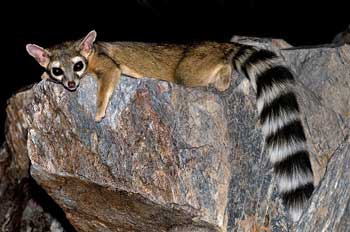BY PENNY COX | DECEMBER 21, 2011

The Ringtail – When is a cat not a cat?
 My interest in the Ringtail [Bassariscus astutus]*, often called the “ringtailed cat,” was tweaked one day by a curious sight outside my bedroom window. I have a small cleared area with a bale of hay as a focal point for all animals that care to indulge.
My interest in the Ringtail [Bassariscus astutus]*, often called the “ringtailed cat,” was tweaked one day by a curious sight outside my bedroom window. I have a small cleared area with a bale of hay as a focal point for all animals that care to indulge.
Rabbits love to play king of the hill on top of this stack, and one evening at dark, I noticed two rabbits (or so I thought) rolling around in the loose hay on the ground (who has more fun!). All of a sudden, the two rabbits became one, scrambled up and then raced off behind a bush, showing for one brief moment that long telltale black tail with faint rings.
Now for the stats: Ringtails normally reside on the upper Sonoran Zone but sometimes can be found in the lower Sonoran Zone in bushy canyons. Their favorite habitat is along cliffs in canyons, where their short legs allow them to prowl the ledges in search of small game, such as pack rats, ground squirrels and, alas, even birds roosting in trees. Ringtails can climb. Days are spent asleep on semi-dark ledges or in hollow trees. Ringtails are about 30 inches, including a tail about 15 inches long, a small animal with large eyes and a foxlike face with rounded ears and black-and-white rings on the tail, hence the name.
Animal tracks: Ringtails have toes on each foot, with no claws showing, and both foreprints and hindprints are about the same, leaving no heel marks. Ringtails are known by other names: miner’s cat, band-tailed cat, civet cat, coon cat, and one unknown to me, cacomistle – Spanish from native Mexican, according to the dictionary. Their range is as far north as southwestern Oregon, California, southern Nevada, also Utah, western Colorado, southern Kansas, south through Arizona, New Mexico, Oklahoma and Texas – a real traveling cat!
They bear two to four young in May or June after a 53-day gestation.
So there you have it, and if, fair readers, you have your own sightings and comments, please come to our next Desert Awareness Committee meeting in Cave Creek. Meetings are held on the 3rd Thursday of each month during the season. Visit http://www.azfcf.org/desert_awareness_schedule.html.
*Order: Carnivora (meat-eaters)
Suborder: Caniformia (“dog-like”)
Family: Procyonidae; raccoons and allies
Genus: Bassariscus; a mammal of the raccoon family (thus not actually a cat)
[Wikipedia]
DECEMBER 21, 2011
Scottsdale Bond Task Force ready to prioritize projects
SCOTTSDALE – What are the priority projects for Scottsdale’s future? Answers to that important question are being developed this week by the city’s Bond Task Force.
Residents and other community stakeholders are invited to share their own views at Thursday’s Task Force meeting set for 5 p.m. at the Granite Reef Senior Center, 1700 N. Granite Reef Road.
The Task Force was formed this summer by the City Council and charged with reviewing and recommending projects for a possible bond election in 2012 or beyond. The Task Force has reviewed more than 40 possible projects to date, carrying a potential price tag of $259 million.
The Task Force is working to keep its recommended list of bond projects within the $150 to $200 million range.
To help create a list of recommended projects, Task Force members earlier this month gave each proposed project a numerical score from 1 to 10 based on a set of technical criteria. At Thursday’s meeting, task force members will review those collective project rankings.
The Task Force will meet Jan. 12, Jan. 26 and Feb. 9 as members continue to formulate a recommen-dation on a future bond election. The Task Force plans to present its recommendations to the City Council in spring 2012.
To view the information on reviewed projects, meeting dates and locations, visit: www.ScottsdaleAZ.gov/BondTaskForce.





